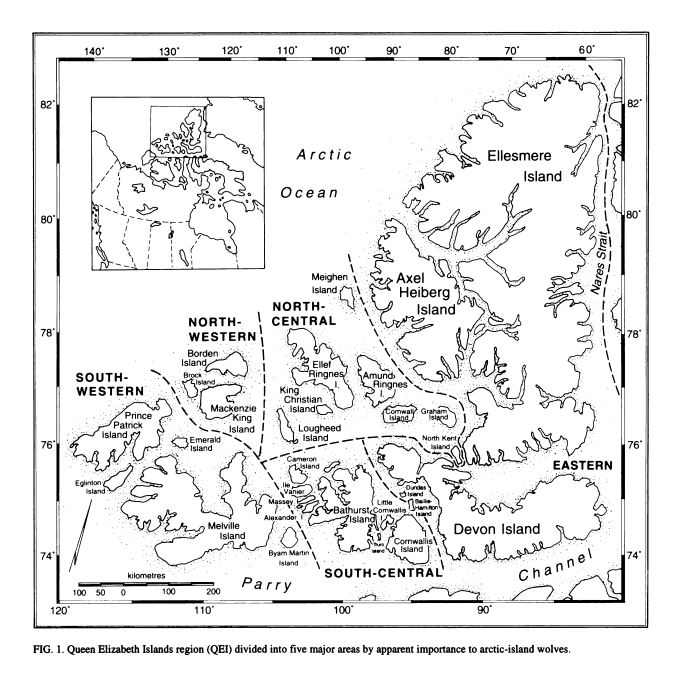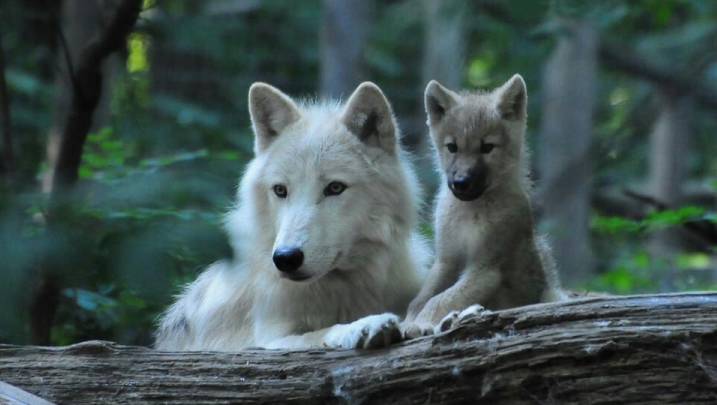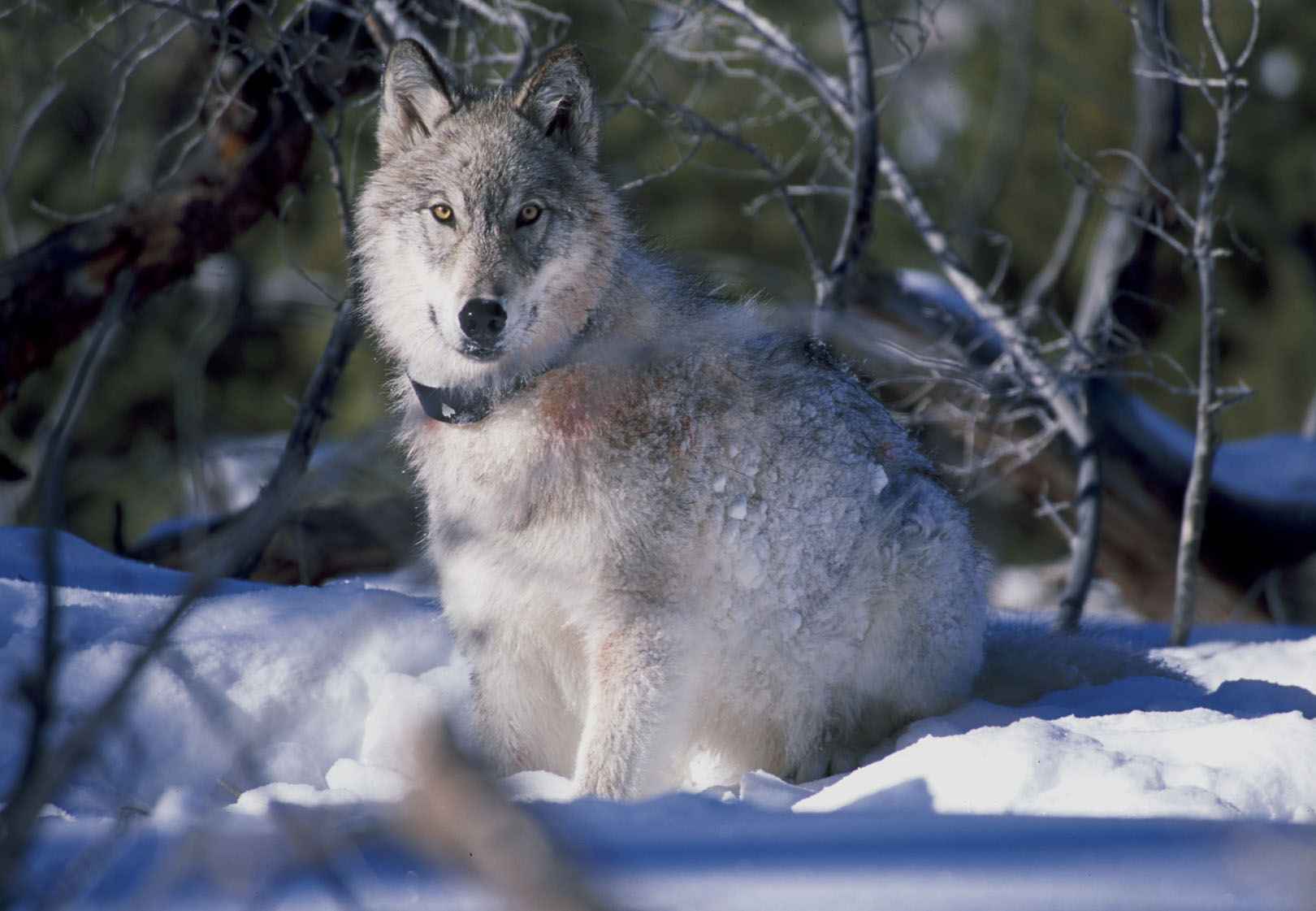
Taxonomy
The Arctic wolf was first described as a distinct subspecies by British zoologist R. I. Pocock in 1935, after having examined a single skull from Melville Island.[6] As of 2005,[7] the Arctic wolf is still recognized as a distinct subspecies by Mammal Species of the World (MSW3). However, studies undertaken on Arctic wolf autosomal microsatellite DNA and Mitochondrial DNA (mtDNA) data indicate that the Arctic wolf has no unique haplotypes, thus indicating that its colonization of the Arctic Archipelago from the North American mainland was relatively recent, and thus not sufficient to warrant subspecies status.[8] However, the research of Chambers et al. (2012) that dismissed the Arctic wolf's genetic integrity became controversial, forcing the United States Fish and Wildlife Service (USFWS) to commission a peer review of it, known as the National Center for Ecological Analysis and Synthesis (NCEAS) (2014).[9] This peer review highlighted numerous flaws in the research such as the erroneous merging of the coastal British Columbia island wolves with the inland Canis lupus nubilus as well as suggesting that gray wolves never lived in the eastern third of the US, and thus concluded unanimously that the Chambers' review "is not accepted as consensus scientific opinion or best available science".
Behaviour
The Arctic wolf is relatively unafraid of people, and can be coaxed to approach people in some areas.[10] It has occasionally acted aggressively toward humans. Otto Sverdrup wrote that during the Fram expedition, a pair of wolves attacked one of his team-mates, who defended himself with a skiing pole.[11] In 1977, a pair of scientists were approached by six wolves on Ellesmere Island, with one animal leaping at one of the scientists and grazing a cheek. A number of incidents involving aggressive wolves have occurred in Alert, Nunavut, where the wolves have lived in close proximity to the local weather station for decades and become habituated to humans.[12]Declining population in east Greenland
The decline and extermination of the Arctic wolf population was studied in east Greenland between 1899 and 1939. Through these years, there were 252 sightings of the wolves and/or their tracks. Of 112 wolves that were sighted in the early winter, 31.3% were lone wolves, 23.2% were in pairs, and the rest stayed together in larger groups.[13] The average pack size of the Arctic wolves was 3.3; packs of four or more were rare. The Arctic wolf population was mainly in the central part of the range, which made them vulnerable to the Danish and Norwegian hunters, which exterminated the population with the use of poison. They are endangered due to their exceptionally low densities, smaller pack sizes, infrequent reproduction, and lower offspring production. The population was not harvested by the Europeans prior to 1899.[14] There was no effort to bring back or grow the population because the main goal was to maximize profits by killing as many Arctic foxes as possible. Arctic wolves were considered less in terms of economic significance because of their low abundance. They were mainly killed and exterminated due to interfering with commercial hunting by killing foxes in traps. Between 1920 and 1932, 35 wolves were killed in the core wolf range, forcing the population to decline rapidly. The Arctic wolf population in five of the six core range areas of east Greenland has severely collapsed and declined rapidly after the arrival of European commercial hunters. There is no other evidence for the potential decline in the Arctic wolf population.[13]
Estimated East Greenland wolf population trajectories based upon
minimum, midrange, and maximum population sizes and reported harvest
plus 0%, 50%, 75%, and 100% undetected kill due to poison use.[15]
 Movement patterns
Movement patterns
The Arctic wolf originated on the Canadian Arctic Islands and in north and east Greenland, hence their name. Very little is known about the movement of the Arctic wolves, mainly due to climate. The only time at which the wolf migrates is during the wintertime when there is complete darkness for 24 hours. This makes Arctic wolf movement hard to research. About 2,250 km (1,400 mi) south of the High Arctic, a wolf movement study took place in the wintertime in complete darkness, when the temperature was as low as −53 °C (−63 °F). The researchers found that wolves prey mainly on the muskoxen. There is no available information of the wolves’ movements where the muskoxen were.[16]
Recovery
The Arctic wolf is of the least concern when it comes to being endangered but it does face threats of endangerment. In 1997, there was a decline in the Arctic wolf population and its prey, muskoxen (Ovibos moschatus) and Arctic hares (Lepus arcticus). This was due to harmful weather conditions during the summers for four years. The recovery of the Arctic wolf population came after when summer weather conditions returned to normal.[17]
The Arctic wolf population also began to decrease as human populations became more dense in certain areas. In east Greenland the Arctic wolf was exterminated completely by Danish and Norwegian hunters. In 1979, they began to repopulate the area and successfully establish a new population of wolves.[18] The first wolf was spotted in April 1978 in eastern north Greenland. During the year of 1980, several wolf pairs were reported throughout eastern Greenland by military patrols. Wolves could not recover during the years between 1939–1978 in east Greenland due to factors such as geography and limited resources. Prey was insufficient and a dispersal corridor was hidden at 79 degrees north, thus restricting access to east Greenland.[14] Also inadvertently, human mediated transport may have contributed to their repopulation in east Greenland. There are studies showing invading wolves of 1979 coming from the north, following tracks left by a military sled patrol.[14]
The Arctic wolf population was exterminated from eastern Greenland during the 1930s by European commercial hunters. They were considered absent for over 40 years. A wolf pair had arrived into a historical wolf range followed by several other wolves over the next four years.[17] This move led to a successful invasion of this area. The evidence suggests that the invading Arctic wolves arrived into east Greenland by unintentional human mediated jump dispersal. Arctic wolves failed to establish a living population in east Greenland for over 40 years due to: a low propagule pressure, invasions were high risk, and only singletons made it into eastern Greenland.[14]
Habitat quality
Habitat quality is the capability of east Greenland to support a wolf population by stipulating adequate prey for wolves to survive and breed. If lack of prey was associated in the decline of the Arctic wolf, then has been an increase in unfavorable weather that caused over-icing and food shortage amongst muskoxen. This factor predicted that one or more severe over-icing events occurred during the 1920s, resulting in calamitous mortality among muskoxen, or that wolves were reported to be abundant enough to reduce the muskox population.[16]
Diet
In the wild, Arctic wolves' primarily prey on muskoxen and Arctic hares. They have also been found to prey on lemmings (Dicrostonyx groenlandicus), Arctic foxes (Vulpes lagopus), birds and beetles. It has been also found that Arctic wolves scavenge through garbage. This sort of food source will not always be found in the Arctic wolves diet because of regional and seasonal availability.[19] Sometimes there is debate whether the muskox or the Arctic hare is the primary prey for the hare-wolf-muskox predator-prey system. Studies provide evidence that the muskoxen are indeed their primary prey because wolf presence and reproduction seems to be higher when muskox is more available than higher hare availability.[20] More supporting evidence suggests that muskoxen provide long-term viability and other ungulates do not appear in wolves diet.[13] Evidence suggesting that Arctic wolves depend more on hares claims that the mature wolf population paralleled the increase of hares rather than muskoxen availability.[21] The study goes on to say that degree of reliance between the two sources of food is uncertain and that the amount of consumption between the two species depends on the season and year.[21] Debate continues when seasonal and diet of young wolves is discussed. According to one study, muskox calves serve as a primary food source because the needs of pups are greater[22] but another study suggests that "when hares were much more plentiful (Mech, 2000), wolves commonly fed them to their pups during summer."[21] These differences may be attributed to location as well.




No comments:
Post a Comment
Note: Only a member of this blog may post a comment.